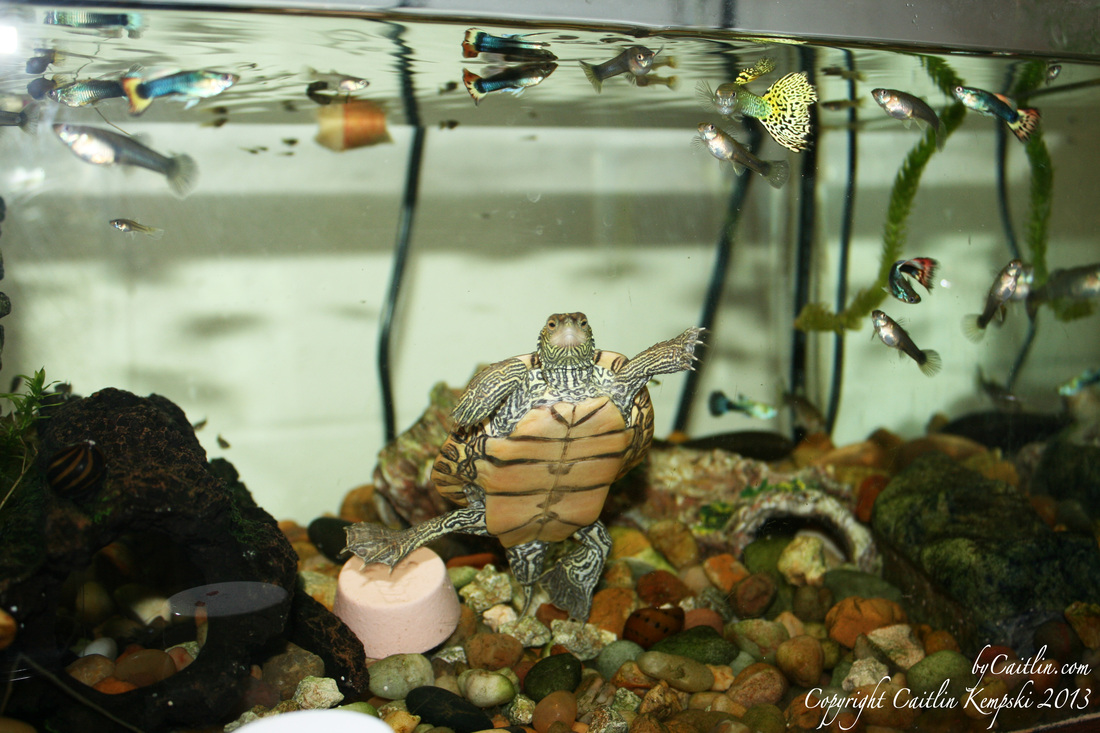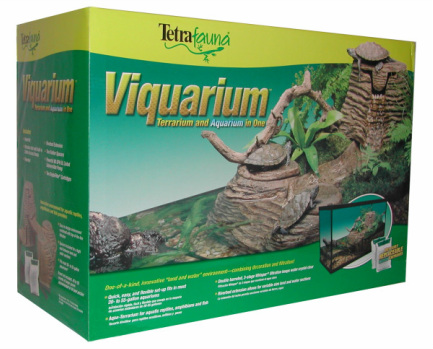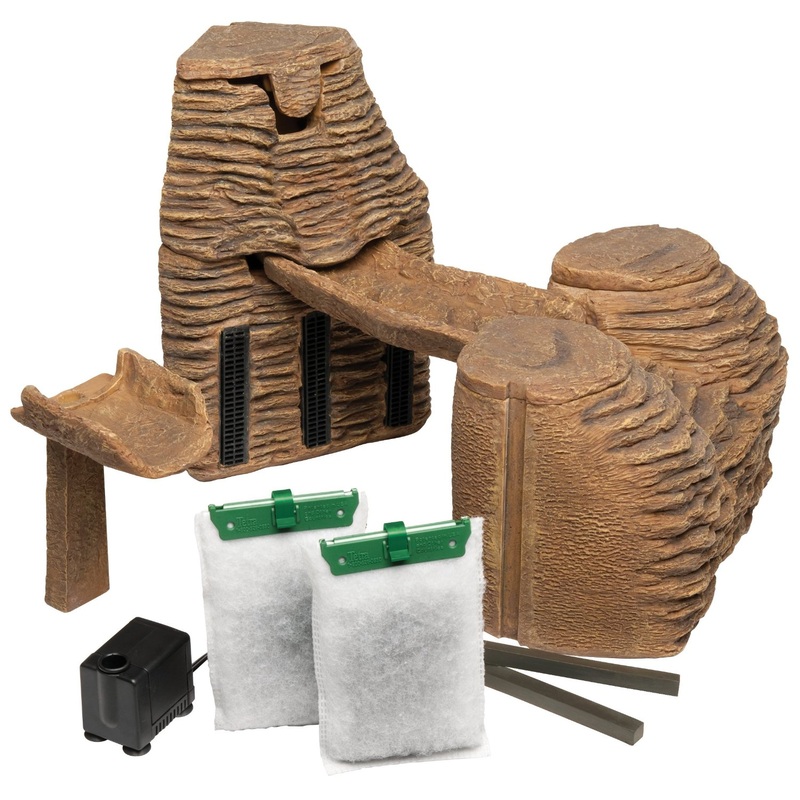Pet Information: Turtles
Water Quality
Poor water quality can stress your turtle and increase their susceptibility to diseases and parasites. It is very important to keep your turtle's water clean and clear. Dirty water not only increases the risk your turtle will get sick, it is the main way you could get sick from your turtle. While any reptile can have Salmonella, the chance is much higher when the tank is not properly cleaned and filtered.
The filter is one of the most important pieces of equipment in a turtle’s tank. Filters remove solid waste, remove dissolved chemicals from the water, and provide surface area for beneficial bacteria that detoxify harmful waste compounds in the water. There are many types of filters: hang-on-the-side, canister filters, sponge filters, and large filter + land area units like the one I own (Viquarium - product pictures below). The most important aspect of picking the right filter is making sure the filter is rated to the size aquarium you have (for turtles it may be best to get the next size larger). This information will be on the filter packaging. It is always better to over-filter an aquarium than under-filter.
The best and easiest way to do water changes is with a gravel vacuum. A gravel vacuum is a large diameter tube connected to thinner, longer tubing. A siphon is started and the wastewater collects in a bucket or gets poured right down the drain. The gravel vacuum sucks waste out of the gravel without removing the gravel itself. Replace removed water with dechlorinated water that is the same temperature as the aquarium water. If you are using tap water, a commercial tap water conditioner must be used to remove chlorine and chloramines. Alternately, well water or spring water may be used to replace the removed water (a water conditioner may still be required if heavy metals are present - some aquarium water test strips can check for this).
NEVER COMPLETELY EMPTY AND CLEAN AN AQUARIUM - YOU WILL REMOVE BENEFICIAL BACTERIA THAT DETOXIFY HARMFUL WASTE COMPOUNDS! The media in an aquarium's filter should be changed once a month to once every other month. Never change all filter media at once unless your filter uses single replaceable cartridges.
Spot clean your aquarium as needed to remove uneaten food.
An air pump, airline hosing, and airstone help provide increased oxygenation to the water. Air pumps are sold based on the size aquarium they are used for, and airstones come in all different sizes and shapes. This is not necessary for a properly sized tank with a large filter, but it does provide extra water movement and many people like how it looks. Some turtles like rapidly moving water, while other species need calm slow moving water, so be sure any extra aeration and water movement does not stress your turtle.
The filter is one of the most important pieces of equipment in a turtle’s tank. Filters remove solid waste, remove dissolved chemicals from the water, and provide surface area for beneficial bacteria that detoxify harmful waste compounds in the water. There are many types of filters: hang-on-the-side, canister filters, sponge filters, and large filter + land area units like the one I own (Viquarium - product pictures below). The most important aspect of picking the right filter is making sure the filter is rated to the size aquarium you have (for turtles it may be best to get the next size larger). This information will be on the filter packaging. It is always better to over-filter an aquarium than under-filter.
The best and easiest way to do water changes is with a gravel vacuum. A gravel vacuum is a large diameter tube connected to thinner, longer tubing. A siphon is started and the wastewater collects in a bucket or gets poured right down the drain. The gravel vacuum sucks waste out of the gravel without removing the gravel itself. Replace removed water with dechlorinated water that is the same temperature as the aquarium water. If you are using tap water, a commercial tap water conditioner must be used to remove chlorine and chloramines. Alternately, well water or spring water may be used to replace the removed water (a water conditioner may still be required if heavy metals are present - some aquarium water test strips can check for this).
NEVER COMPLETELY EMPTY AND CLEAN AN AQUARIUM - YOU WILL REMOVE BENEFICIAL BACTERIA THAT DETOXIFY HARMFUL WASTE COMPOUNDS! The media in an aquarium's filter should be changed once a month to once every other month. Never change all filter media at once unless your filter uses single replaceable cartridges.
Spot clean your aquarium as needed to remove uneaten food.
An air pump, airline hosing, and airstone help provide increased oxygenation to the water. Air pumps are sold based on the size aquarium they are used for, and airstones come in all different sizes and shapes. This is not necessary for a properly sized tank with a large filter, but it does provide extra water movement and many people like how it looks. Some turtles like rapidly moving water, while other species need calm slow moving water, so be sure any extra aeration and water movement does not stress your turtle.
The stream has two parts, one longer than the other, so that you can decide how long you want the land area to be. It can curve to have the waterfall in either the right or left corner when looking down the stream, so you can place it on either side of your tank. When I move I will be buying a larger tank for Leonardo, and am getting one 24 inches wide so that I can put two of these side by side! I love how well it works, and can't wait to have even more plant-able land area and room for Leo to explore.
|
Please let me know how you used these resources; if they were used in the classroom to help cover State Standards, if they were used at home, or if they were used in another setting. I welcome any other constructive feedback or ways you adapted them to meet your needs, responses do not need to be long to be helpful.
|
I use Groupon and love it, but I do not endorse the individual deals shown.
Click here to make a website of your own!
I use iPage to host my website, and I am very happy with the service. The Weebly Drag and Drop Site Builder lets me create custom pages with no experience, and the support staff is helpful and patient. Hosting at iPage is affordable, even with the upgrade that allows me to create and display unlimited pages with their site builder software.
Disclosure: I do receive payment if you open an iPage account by following this link. The iPage Affiliate program allows me to earn money through referrals, which I use to develop and post the educational resources on this site free of charge. |

Pet Information - Turtles by Caitlin Kempski is licensed under a Creative Commons Attribution-NonCommercial-ShareAlike 3.0 Unported License.
This license means that you can remix, tweak, and build upon my work non-commercially, as long as you credit me and license any new creations under these identical terms.
The above information is intended to be a resource for educators and can be used freely, so long as I am credited and you are not selling it in any way. Handing it out to students of any age as is or in an edited form is acceptable and encouraged, just include the link to this webpage and identify it as your source. If you post it on your website, be it personal or school affiliated, it must also be credited to me and grant people identical terms of use. Thank you for your cooperation and please email me with any questions at bycaitlin@gmail.com. License terms can be found here http://creativecommons.org/licenses/by-nc-sa/3.0/
The above information is intended to be a resource for educators and can be used freely, so long as I am credited and you are not selling it in any way. Handing it out to students of any age as is or in an edited form is acceptable and encouraged, just include the link to this webpage and identify it as your source. If you post it on your website, be it personal or school affiliated, it must also be credited to me and grant people identical terms of use. Thank you for your cooperation and please email me with any questions at bycaitlin@gmail.com. License terms can be found here http://creativecommons.org/licenses/by-nc-sa/3.0/







